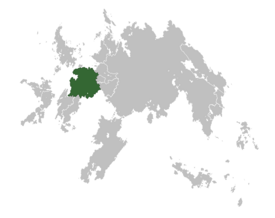User:Finium/Sandbox3
Cathartic Empire of Cornicae | |||||||||||||
|---|---|---|---|---|---|---|---|---|---|---|---|---|---|
| Anthem: Hymn of the Wood | |||||||||||||
 | |||||||||||||
| Capital | Cambra | ||||||||||||
| Religion | Cathartic Ditanery | ||||||||||||
| Demonym(s) | Cornice | ||||||||||||
| Government | Monarchy | ||||||||||||
| High King | |||||||||||||
• 1605-1665 | Marius I | ||||||||||||
• | ... | ||||||||||||
• 1905-1943 | Peter X | ||||||||||||
| Population | |||||||||||||
• 1700 | 22,011,803 | ||||||||||||
• 1800 | 31,183,388 | ||||||||||||
• 1900 | 59,615,301 | ||||||||||||
• 1940 | 76,124,153 | ||||||||||||
| |||||||||||||
| |||||||||||||
The Cathartic Empire of Cornicae, later called the Lavarian Empire, was a large imperial state in western Gaia that was active from the early 17th century to shortly after the conclusion of the Continental War. Prior to the Piloro's endorsement of the reigning monarch Marius I, the House of Cambra ruled a parallel state called the Kingdom of Cardeale and Bracelon. In 1605, the Piloro recognized Marius I as the paramount physical authority of Ditanery and legitimized his annexation of Brilliania, during which he deposed the Marist Princes who had previously denied the religious authority of the Piloro. Throughout its development, the Cathartic Empire was closely linked to the authority of the Piloro and the enforcement of Ditanist world views.
History
Marmor Dynasty
Reformation
The Reformation, also known as the First Reformation and the Lesser Reformation, was a period of political and economic reform under the reign of the Queen Mother Sibyl, who was regent for High King Aspidistra I until her death in 1698. Most of the work of the Reformation was done at the beginning of Aspidistra I's reign and mainly involved the removal of the Queen Mother's political opponents and the centralization of authority under the monarch.
War of 1740
The War of 1740 was a civil war fought between the supports of Aspidistra I's cousin Maganza (the Magazines) and the supporters of Barnabé, a distant relation of Marius I who represented the interests of the Ditanist clergy. Ultimately, the Magazines were victorious and secured the rule of the Marmor Dynasty until 1800.
Tordo Dynasty
The Tordo Dynasty was established in 1800 when Patrícia married Maximo de Tordo who reigned as Vencedor. Vencedor's rule was disastrous and fraught with violence. The Torporine Orders were nominally chivalric orders established by Vencedor to suppress dissent in the empire, which was typical of Vencedor's and also why he managed to maintain power over the course of his forty year rule. Vencedor's son and grandson attempted to rein in the power of the Torporine Orders and were deposed as a result.
Sarga Dynasty
The Sargas initially ruled under the control of the Torporine Orders, but Alfonso, an ennobled member of the family quickly usurped the throne with the support of a peasant rebellion only three years after the first Sarga monarch was crowned in 1840.
War of 1843
The War of 1843 was fought between Luis o Sarga and and Alfonso o Sarga. Alfonso's faction, which had the support of the commoners, was victorious, but did not entirely eliminate the Torporine Orders from government.
Treason of the Burguês
The Treason of the Burguês, which is also called the Treason of the Burghers, was a political movement of the urban professional class in the early 1880s that involved industrial sabotage and civil disobedience. The movement was focused on the large trading city of Antiarro and eventually turned into a violent rebellion when the government cracked down on political dissent. This period saw a return of the Torporine Orders, which had been pushed to the periphery of the state forty years earlier.
War of 1850
The War of 1850 was an attempted palace coup by the Torporine Orders. While they managed to arrest and execute the monarch Alfonso II, they were not able to maintain control of the capital. An army raised by the Duke of Rodriguy (modern Rodenia) came to the rescue of the Sargas. Alfonso II's nephew was crowned in the aftermath as Alfonso III with the Duke of Rodriguy as regent for the first few years of his reign.
Great Reformation
The Great Reformation, also called the Second Reformation, was a period of political changes instigated by Alfonso IV's prime minister, Marcelino de Zaragoza, in 1890. This shifted the empire towards absolutism and rejected some of the customs of Anxship and also pushed the Adelthon to the periphery of society by granting more rights to Ditanist citizens.